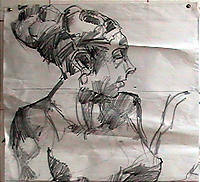| |
 "Cartoon"
- full scale drawing of the future fresco. "Cartoon"
- full scale drawing of the future fresco.
Cartoons are drawn on regular paper
with pencil, graphite, charcoal, sepia chalk, etc., etc. The purpose of a
cartoon is a thorough study and final rendition of the composition, light,
shadow, details of the future fresco, it is a preparatory drawing taken to the
next level. Correctly done cartoon is a "stand along" artwork. Although optional
in other painting mediums, Cartoon is essential when painting in Fresco not only
as the main guideline for transferring the design onto freshly laid (fresco)
plaster, but also as the main tool and method of understanding and orchestrating
the steps for painting of the corresponding fresco.
Preparation of the cartoon for small fresco slightly differs from
the preparation of the large fresco cartoon. In this article we discuss the
small fresco cartoon. Since this article is intended for the general audience
and/or beginner fresco artist it makes sense to illustrate the directions with
the actual examples from our fresco workshops. During our workshops artists work
from their own cartoons that they have to prepare at home prior to the class.
Since many of our students have little or no practical experience in fresco we
do not judge nor expect students cartoons to be perfect or even fully completed.
However it will be helpful to establish some guidelines and explain the reasons
behind them.
Verne Busby flew from Canada to take our workshop in 2003, his
cartoons prepared for the class surpassed all our expectations to the point that
we will use his work to illustrate this article. Please keep in mind we are not
looking for or suggesting a particular style; on the contrary we hope that we
will have a wide variety of "styles" (aka: modern, abstract, classic,
representational or not) present during the class, so students can experience
and share as many alternative methods and solutions to achieving desired results
on plaster as possible. The "guidelines" are directed to explain the "uni-system"
of building up color, shadow, depth and contrast when working in fresco.
Surmising we can say that "Cartoon" is a "Checklist" for the steps in actual
painting on wet plaster. You will repeat this steps one by one using color while
painting the actual fresco and the result directly depends on how clear and how
complete this "Checklist" is!
|



